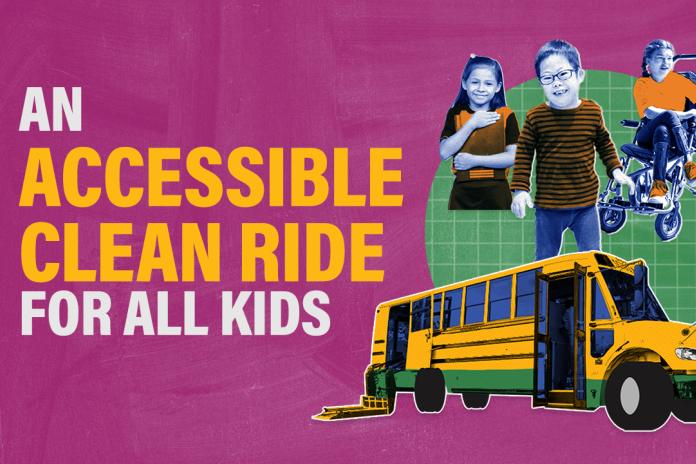Prioritizing Students with Disabilities in the Transition to Electric School Buses
How can you help students with disabilities secure a safe and accessible clean ride to school?

Students with disabilities rely on school transportation more than their non-disabled peers, and face additional barriers to a reliable, safe and accessible ride to school. But the transition to electric school buses presents a real chance to reduce exposure to diesel exhaust pollution and address accessibility issues for students with disabilities.
Students with disabilities, their parents, school district and transportation professionals, and advocates report a variety of safety risks that students with disabilities face when riding on school buses. These issues include unreliable wheelchair ramps and lifts, untrained or inexperienced bus operators and monitors, and insufficient or missing accessibility features for students with various disabilities. Additionally, students with disabilities often endure longer commute times than their non-disabled peers, resulting in prolonged exposure to harmful diesel exhaust pollution.
Disabled students in underserved low-income communities and communities of color face compounded transportation infrastructure and access issues due to historic disinvestment.
These intersecting and compounding issues can or have caused real harm to students with disabilities today. But as school districts transition to electric school buses, we have the opportunity to address these problems and offer a better way forward — and we all have a role to play.
How Electric School Buses Can Improve School Transportation for Disabled Students
Accessibility issues are likely to persist during the transition to electric fleet vehicles unless they are specifically and intentionally addressed. The transition to electric school buses underway nationwide now offers a unique opportunity to more inclusively define accessibility and how we better transport students with disabilities.
And since electric school buses (ESBs) have no tailpipe emissions, the transition to ESBs offers compounded health benefits for disabled students who experience longer commute times and exposure to dangerous diesel exhaust. A clean ride to school is especially needed for disabled students in underserved communities with elevated air pollution.
Already, districts that have begun their fleet transition have reported a better riding experience for students with disabilities. Because ESBs do not have an internal combustion engine, they are quiet and do not have the vibrations or onboard exhaust of their diesel-burning counterparts. This helps provide students with stimulation sensitivities a more comfortable ride to school and a better start to their day.
As students nationwide start to experience the benefits of electric school buses, school districts, policymakers and manufacturers have the opportunity to identify and implement truly accessible school bus designs and school transportation systems for students with disabilities.
How You Can Help
School Districts and Fleet Operators
- Include accessibility features, such as a wheelchair ramp or lift, on every school bus to create universal transportation access for students with disabilities.
- Prioritize the electrification of school buses that serve students with disabilities along with other underserved communities.
- Include disabled students and their families in all phases of the transition. This includes actively soliciting input, proactively engaging (rather than waiting for them to reach out) and creating engagement opportunities in multiple forms, such as hybrid meetings, surveys and focus groups. This also includes offering a feedback process in multiple formats for all engagement activities.
- Appoint multiple disabled students to all advisory boards connected to the transition, with inclusive meeting protocols and processes.
- Ensure current and future fueling sites are accessible for bus operators and mechanics to foster opportunity for a disability-diverse workforce.
- Consistently address safety risks through improved training for school bus monitors and school bus drives, and increased transportation staff and service capacity.
- Explore additional accessible transportation or resilience uses for ESBs, such as mobile libraries, charging stations or emergency evacuation.
Policymakers
- Reevaluate the existing policy guidance and accountability framework to ensure school districts comply with the Americans with Disabilities Act (ADA) and Individuals with Disabilities Education Act (IDEA), moving away from the current complaint-driven enforcement system.
- Incentivize school districts and fleet operators to prioritize transitioning school buses that serve students with disabilities through funding programs.
- Increase the number of accessible school buses through policy requirements.
- In program design, give priority to funding applications that request accessible ESBs along with other underserved communities, and provide additional funds to school districts purchasing accessible ESBs.
Manufacturers
- Develop and provide innovative accessibility specification options for disabled students.
- Promote the availability of various accessibility specifications to school districts procuring ESBs.
- Resolve existing design issues, particularly malfunctioning wheelchair lifts that are unreliable and unsafe for students, school bus drivers and monitors.
- Establish universal design as the industry standard.
- Consult with disabled students on accessible school bus designs. For example, one issue raised by students includes the need for a reliable remedy to steep school bus stairs. Students with mobility disabilities who do not use wheelchairs or feel unsafe standing or sitting on a lift often can only board via the stairs.
Students and Community Advocates
- Tell your school district to purchase 100% accessible electric school buses.
- Advocate for meaningful disabled student representation in decision-making processes, such as advisory boards and design committees.
- Report violations of the ADA, IDEA, and Section 504 of the Rehabilitation Act of 1973 to ensure enforcement.
An Accessible Clean Ride for All Kids:
An Accessible Clean Ride for All Kids (Audio Description version):
Where Can You Learn More
- Next stop, access! An exploratory paper on disability rights and justice throughout the transition to electric school buses – WRI’s Electric School Bus Initiative and SeededGround
- For Students with Disabilities, Electric School Buses Could Transform the School Commute – WRI’s Electric School Bus Initiative and SeededGround
- 10 Principles of Disability Justice – Sins Invalid
- Principles of Environmental Justice – People of Color Environmental Leadership Summit
- Design Recommendations for Accessible Electric Vehicle Charging Stations – U.S. Access Board
- Planning Accessible Meetings and Events – The Disability & Philanthropy Forum